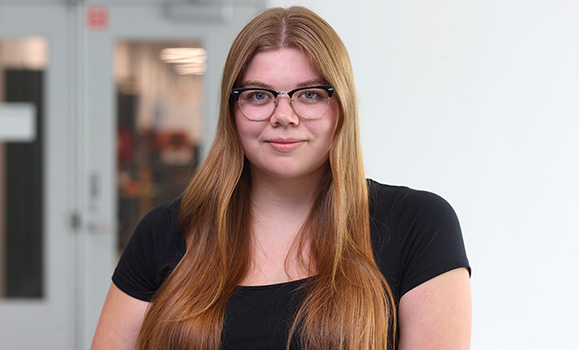For Jessica Durham, her first year at ±«Óătv’s Faculty of Engineering was nothing short of a solar experience. It began with a bold decision to join the  team and ended on a racetrack in Bowling Green, Kentucky.Â
such as Dal Solar Car, also known as DalSol, provide students with valuable hands-on experiences that bridge classroom learning with practical application. These teams allow students to engage in engineering challenges that foster teamwork, problem solving, and innovation.Â
“At the beginning of last year, I went on a campus tour of Studley and Sexton, and I saw the electric car and solar car through the garage shop window," says Jessica. "I didn’t realize these kinds of opportunities were available to first-year students."
She started following a few of the design teams on social media and even applied to join Formula SAE, another automotive group, but was too nervous to go to a meeting.
By January however, she’d found the confidence to attend her first meeting on the Dal Solar Car team. Seven months later, she was cheering on her teammates as they competed against 32 other university teams from around North America at the Formula Sun Grand Prix.
Team triumphs
A relatively new group in the Faculty of Engineering, DalSol was formed in 2021. By 2023, they made regional headlines as the first team in Atlantic Canada to build a solar car. Weighing 270 kilograms and reaching speeds up to 65 kilometers per hour, the car runs on solar power, converting sunlight into electrical energy to charge its battery and motor controller.
Despite being newcomers to the solar-racing scene, the Dal team earned an impressive fourth-place finish in the Single-Occupant Vehicle class at the 2023 Formula Sun Grand Prix, along with the Best New Team Scrutineering award. With that success under their belts, this year’s team headed back to competition, this time in Kentucky.Â
The Formula Sun Grand Prix is an annual three-day event where university teams race their solar cars on closed circuits. This summer’s race, held at the National Corvette Museum Motorsports Park, challenged the teams to complete as many laps as possible using only solar energy. For Jessica and her teammates, the experience was more than just the opportunity to test their car’s limits. It was a chance to network with competitors from leading universities around North America and learn more about the future of solar-powered energy.Â
“It was really interesting to engage with teams from the U.S. universities that I would otherwise never meet,” she says.

Jessica with the Dal Solar Car in Kentucky.
Race hurdles
Before the big race can start, solar cars need to first pass the scrutineering process. This involves a series of vehicle inspections and checks to ensure everything is functioning properly and meets regulations. During this phase, cars undergo thorough safety, mechanical, and electrical tests. ±«Óătv placed second out of the 32 teams in scrutineering.Â
"Our team lead, Noah, drove the car first, but as the race started, the BPS (Battery Protection System) tripped and shut off the car," explains Jessica, remembering the scramble to fix the issue. After some troubleshooting, they were back on track.Â
On day three, she found herself front and centre in middle of the action, serving as corner authority, tasked with monitoring a section of the track.Â
"I was standing at my corner, and then suddenly there was a pile-up. MIT, Principia, and Montana State were all stopped on the track. I had to radio in, and we got the red flags out to stop the race."Â
Despite the chaos, Jessica says the experience was surreal and an incredible way to end her first year of engineering. Looking back, she says she’s amazed by how much she learned throughout the journey, not just about solar cars, but about teamwork and communication.Â
"I learned so much about the cars electrical system," she says. "There’s a lot of components that go into the car to make it drive, so I took a lot of notes."
Future focus
Now in her second year of engineering and officially enrolled in the Electrical Engineering program, Jessica is eager to dive deeper into the design team.Â
“I am looking forward to my new positions on the team as fundraising lead and internal relations, as well as my original role as electrical support,” she says.Â
She explains that it’s an exciting time for new students to join, as the team will be designing and building an entirely new solar car from the ground up this year.Â
"You just have to do it," she says, advising first-year students why they should consider joining one of Dal Engineering’s student design teams. "Go introduce yourself, make connections. We’re a welcoming group, and once you’re in, you’ll wonder why you didn’t do it sooner."


